#folklore and christianity
Explore tagged Tumblr posts
Text
Creatures in swedish folklore as a whole are sometimes known as "de underjordiska" - the people from underground or "det dolda folket" - the hidden people So why is that a thing? Well. Most o the time they are hidden or invisible to humans and choose when they want to be seen. But there is also a story involving Adam and Eve as well as God himself. The story goes that Adam and Eve had a lot of children running around behaving like children do. One evening God came for a visit and was met with open arms buy Adam and Eve. Their children ran up to God in delight while smelling of soap. Each child had wet but clean hair. God met them all with joy and smiled brightly. Though it didn't take long until he frowned and looked around before facing Eve. "Is this really all the children?" "No, there are no more children to show you." She responded. It was not all true as she had more children hidden away since they were dirty. This lie flew out of her mouth since she was scared that God would think of her as a bad mother for not washing all of her children. Truthfully God arrived before Eve had bathed them all. There was also a sense of shame that he would see her precious children being dirty. Instead she hid them away in the shed.
However, it was impossible to keep anything from God's view as he saw and knew it all. Truly he only wished for her honesty. "That which are hidden from God the almighty will from now on be hidden from humanity." As the words came were spoken each child who had been hidden could no longer be seen by ordinary eyes. Each child found homes in deep mountains, hills or under rocks. With time they had children of their own which became elves, trolls, goblins and other folks who live underground. Humans are relatives to those children who was bathed and met God that fateful day in the beginning of time when Adam and Eve was alive. This is why humans cannot see hidden people unless they want to be seen.
--- This story I made a summary of is written by Line Therkelsen and Sissel Sommer Steneby. The story is a part from a christmas anthology series about nordic folklore, traditions, fairytales and so much more. Some stories are dark and brutal while others are bisarre. Then there are some wholesome stories as well. I love the illustrations and storytelling.

1 note
·
View note
Text

| Christian Louboutin on designing Taylor’s shoes for The Eras Tour
""Her being on stage for two years all around the world, she needed to sparkle and stand out. So for each date, there were new fittings and shoes to surprise her fans.
Taylor launching a new album while on tour was such a big moment, The Tortured Poets Department shoe is my favorite and she played it for the first time in Paris.
Each pair is made to fully to allow for quick changes through the entirety of the show. As they are dancing for over three hours, comfort is also extremely important. So we incorporated a
sturdy block heel and also flats.
It was very emotional to accompany her in such a big moment in her career, I adored the Red era, when she was wearing her lyrics on a white T-shirt paired with the loafers, It was cute! It creates such a fun college vibe."
#eras taylor swift#lover taylor swift#taylor swift#eras tour#lover#midnights#all too well#folklore#the eras tour#speak now#christian louboutin#the eras tour book#the anthology
1K notes
·
View notes
Text

†
#goth#gothic#night#chapel#church#appalachian trail#appalachian folklore#appalachia#rural#christianity#rural america#rural photography#rural decay#rural life#midwest
1K notes
·
View notes
Text


#goth#gothic#gothcore#rural#midwest#religion#religious imagery#christianity#rural america#appalachia#appalachian folklore
1K notes
·
View notes
Text

Piotr Stachiewicz - “Regina Caeli”
#girlblogger#catholic aesthetic#catholic academia#Catholic#catholica#Christian#god loves you#Jesus loves you#repent and forgive#I’m a sinner#glory of god#church aesthetic#appalachian horror#southern gothic americana#Americana#southern gothic#gothic#Appalachian gothic#Appalachia#appalachian folklore#Virgin Mary#blessed mother#girlblogging#girly things#cinnamon girl#lux lisbon#lana del rey#lizzy grant#coquette#salve Regina
968 notes
·
View notes
Text
I don't want to act like a snob, but, y'all... really don't read old fairy tales or mythology, do you...? You only know the sanitized, bloodless Disney versions? People get cut to pieces (Cinderella/Ashputtel, The Red Shoes), women are abducted to be wives (an upsetting practice that continued until very recently, still practiced in some countries today—horrible, but part of life that found its way into stories, like The Seal's Skin), and magical talking animal husbands / wives (The Crane's Return of a Favour; East of the Sun, West of the Moon, etc.) abound in old mythology. Kids have been raised hearing these stories and not thinking about sex for centuries...
Humans marrying Pokemon in the ancient past was frankly stated in the Japanese version of DPPt. The English version rightly assumed English-speaking fans won't take it and reworded it from used to marry to used to eat at the same table (some euphemism!)



The Typhlosion story is no different from western stories like East of the Sun, West of the Moon (the way she was advised not to look at him reminded me of that) or The Seal's Skin (selkies cannot transform and return to the sea without their pelts—the abducted wife leaves her half-human child on land, escaping with her pelt when she finds it... the half-human, half-Pokemon children are bullied by their pelts being thrown on them to transform them against their will for cruel human amusement..)
The bloody myth about the boy with the sword is Veilstone's myth, but told in detail, right down to the Pokemon exacting a toll from him for how he maimed and slew them for amusement.
A man unknowingly marries a transformed-into-human form Froslass he met once before in Pokemon Legends: Arceus and she flees when he finds out what she was... it's based on a tale about the yuki-onna, the folkloric snow woman Froslass is based on.
youtube
[music]
#Pokemon#teraleak#Pokemon Leaks#fairy tales#I don't wanna act like a snob but DANG you guys are that divorced from culture PLEASE read Grimm's Fairy Tales Hans Christian Andersen#Greek myth Celtic folklore Japanese folklore—anything!!!#I get being horrified by the implications of rape * definitely but those elements are only perceived with knowledge of adult matters#fairy tales always had some darkness to them that was gradually sanitized out in modern retellings#Youtube
393 notes
·
View notes
Text












Gagauz: The Descendants of the Wolves
"In the south of the Republic of Moldova lies the small autonomous region of Gagauzia. Here lives a largely unknown people with old traditions and customs: the Gagauz, a minority of ethnic Turks with Christian Orthodox faith, the descendants of the Wolves.
According to legend, after an enemy raid, a she-wolf discovered a little boy who had miraculously survived in the forest and took care of him. This boy became the ancestor of the Gagauz people.
But very few young people decide to stay in the land of their ancestors. Older people proudly try to preserve their identity, their traditions and, above all, their language in order to continue on the path to the independence they long for."
164 notes
·
View notes
Text
My Current Inventory of Magic Tools
Here's a list of tools I use in my spiritual practice that can inspire others that are on this path! While some are heritage pieces that cost a lot of money up-front due to craftsmanship, the every-day tools are pretty inexpensive. For example, most candles can be found at the dollar store, and incense can be personalized to your taste. For my practice, I use cedar incense, since it is known as a cleansing plant in the Christian tradition, and many Acadian and Québécois households used cedar on Palm Sunday before palms became widely available.
Most of the heritage pieces, for anyone wanting to participate, I strongly encourage investing a few extra dollars to get good quality items! It will last you years of magical practice, and you can use them with pride.

La ceinture fléchée - the woven sash
A symbol of identity to the Métis living on the Canadian plains, the historical Huron-Wendat people, and historically worn by French voyageurs and fur traders and their indigenous partners in trade, these sashes were strapped around the waist. These were mostly useful in keeping the woollen coats closed, store belted tools, help with the strain of carrying heavy pelts, and prevent hernias and back strain on long canoe expeditions. The long strands on the end could also be used as impromptu sewing thread. These sashes would reach about 15cm to 25cm and its length easily passes 2 metres. These sashes were traded among indigenous groups for furs, and later, by the Hudson's Bay Company in the 19th century. It became a part of the traditional Québecois peasant clothing at least since 1776. As the sash travelled upriver to the plains and beyond, Métis groups adopted the sashes, elaborated on its craftsmanship, and truly made it one of their most recognized symbols. Depending on where the sash is woven, the colours can change. For example, for Québec, they preferred a blue colour scheme, for Montréal, red, and for those woven in between Ottawa and the Red River, black was more prominent. Hand-woven sashes can take up to 500 hours to complete. (1)
The one pictured above I bought from Etchiboy, a Métis artisan. The sash I bought was inspired from the Assomption sash motif, one of the oldest known woven patterns from the 18th century. I wear it on my woodland wanderings, for rituals, and cultural days. I especially wear it in winter to keep my coat closed. I chose to adopt the sash into my practice after lots of research. It is an item of rich history between the French and their indigenous allies, and a consequence of the fur trade in our country. I encourage anyone who's interested to buy from artisans who hand-weave them! There are machine-woven ones nowadays that might be less expensive, but nothing beats the quality of good wool and good weaving. With the richness of variety in the weaving patterns depending on the region they're from, why not have a sash that harkens back to the history of your region?

The walking stick or 'le gourdin'
In Québécois folktales, the stick, known as 'the gourdin', was most seen as a gift from a woodland fairy (like a guardian of all trees, or a mistress of the birds) to the intrepid hero Ti-Jean. This magical stick could thwack all his adversaries with the simple command of "tappe, gourdin!" (slap, stick!), among other fabulous deeds (2) This stick was a tool of protection on long journeys fraught with peril. So, what better companion to the Canadien witch than a walking stick? I use mine for every excursion, and have added to it some talismans of a wolf, owl and skull to keep evil spirits at bay. There's also a portable rosary around the stick, and the Ste. Anne of Beaupré religious medal. Historically, she was often a saint prayed to by voyageurs before they undertook the long and perilous journey to the fur trading posts, usually near present-day Montreal. (3)

The pocket knife
The pocket knife is a multi-talented tool of our trade! It can carve folksy figurines, cut wooden branches for weaving, harvest plants, cut curses, and keep les feux-follets (willow-the-wisps) at bay. Folklore has it that if you're out camping in the woods, fold you knife so that it creates a 90-degree angle, and stick it into the bark of a tree bordering your campsite. In the morning, if the blade is bloody, chances are it was the feux follet being intrigued by the space between the blade and the tree, and cutting its throat, thereby being free from its doomed roaming. (4) It is also a well-known tool in case you need to free a loup-garou (werewolf) from its curse by cutting it on its white spot on the forehead where he previously received communion as a kid. (5) By extension, it is a vital tool to break curses. Of course, don't make anyone bleed with the knife. That goes without saying. Treat the knife well, keep it sharp.

The rosary
Yes, my path has Catholic tools in it. Of course! Quebecois and Acadians of my ancestry were Catholic people primarily. It is a versatile tool in my practice, used for spellwork as well as meditative prayer. For those who are interested in praying the Rosary traditionally, I'll create a separate post. For spellwork purposes, I usually say a round of "Hail Mary" ten times before starting a spell for the ultimate protective shield. There is also known folk uses for the rosary in Acadian and Québécois communities. For example, to fidget with the rosary without intent or purpose brings about the Devil. (6) The rosary can also be used as a tool to find lost items. Simply toss the rosary over your shoulder, and the crucifix will point in the direction of the lost item. If you want good weather on your wedding day, hang up your rosary on your laundry cord the day before. (7). Rosaries nowadays even come in decade forms as portable rings for your pocket, and some are actual rings you can wear on your finger. I got a few rosaries myself. One for special rituals (I never toss that one over my shoulder!), and cheaper, more portable options for the tossing spell.
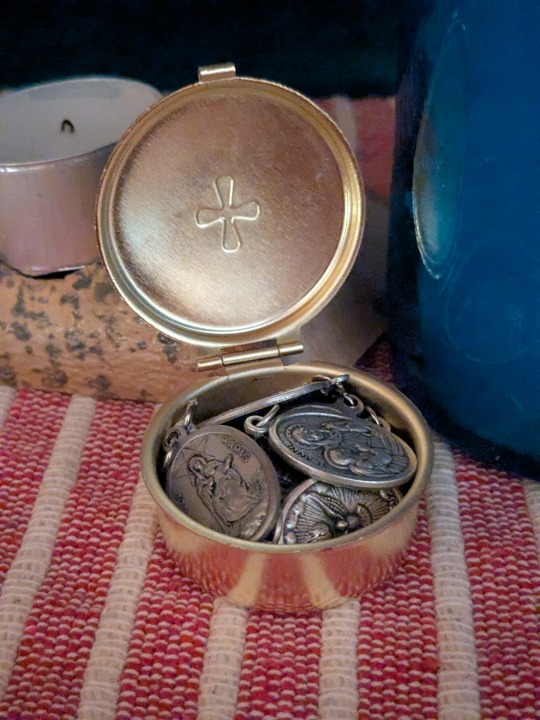
Holy medals
I amassed quite a collection of holy medals for individual saints. Other notable ones are those for the souls in Purgatory (worn on All Souls Day), the Holy Spirit at (worn on Pentecost or when I do divination), Jesus the Shepherd (it's comforting), Stella Maris (patron saint of Acadians). I have a few of the same for more frequented purposes, for example, I keep a Saint Luke medal on my artist's pencil case, since he is the patron saint of artists. Traditionally in Acadian communities, it was known that when your day was going awfully, and your bread dough just wouldn't rise, you just needed to boil some holy medals in water to turn your luck around (8). They are quite inexpensive, so it's fast and easy to grow a collection in a short period of time. Many catholic retailers sell them.

Divination tools : the playing cards, dice and coin
My divination tools can be found in anyone's cupboard and drawers. The trusty playing cards deck nowadays comes in such amazing variety of art, the one I picked for myself was the Bicycle Aviary Playing Cards. It has such a lovely folk art vibe to them! The way to divine them comes from sources of card-playing and superstitions from history and folktales from folklorist Marius Barbeau, and people over centuries carrying around the cards for entertainment and perhaps a glimpse into their futures. One guide on reading the cards: Fifty-Four Devils: The Art & Folklore of Fortune-Telling with Playing Cards by Cory Thomas Hutcheson. Dice can also be used in the same manner if you're doing a numerology-based divination. The coin can be used as a simple yes or no divination by playing 'heads or tails'. The coin can be a beautiful commemorative coin like mine, or a simple 'cenne noire' (blackened penny), or whatever currency you have on hand.

The sewing kit and fibre arts
I wanted to add this iconic cookie tin into the folk witch's repertoire, because we all had grandmothers who had this tin lying around with their tools to mend and sew anything. In my practice, and in my hobbies, I make clothing and I embroider. I can use this tin to house my relevant supplies to have some sacred time darning old socks, creating spiritual garments by hand, or embroidering pretty things. You can also draw sigils on the rim's inner side for blessing your items inside! There's also other uses for some of these tools in your home! For example, my great-great grandmother used to use her thimble to create the holes in her croxignoles, these woven doughnut style rings from the Magdalen Islands.

Musical spoons
Musical spoons, sometimes made of wood to be used for musical purposes, as shown here, or made from every-day metal spoons held together for the same effect, are an iconic instrument in French-Canadian folk music. I would recommend learning how to play them rhythmically and to use that as a grounding tool. I just find these way more authentic than a drum. Not to mention rhythmic foot tapping and step dances are frequently used in our folk music to set up a beat.

Woven Cloths
These beautiful cloths or 'serviettes' were woven by my mother on a giant hand-loom, often employed by local farmer's guilds in Québec. Les Cercles des Fermières du Québec sometimes has craft fairs where they sell these among other hand-crafted items. In folklore, the cloth was present when Ti-Jean needed to create a magical feast on the fly, create a magical tent for shelter, or carry around all his tools for his journey. These cloths however were almost always given by a fay creature, so best be cautious in eating food from it. Nowadays, it can be used as altar cloths, protective shields for your tools, or to apply healing energy to an ailment you carry. (9) I use mine to do my card readings, wrap special items. If you are lucky enough to find a 'catalogne', which is a heavy blanket woven on those big looms from scraps of old t-shirts, cottons and the like, that's like, a massive cloth you can have over your bed and its folkloric properties can be used for protection and good dreams. It is also the best weighted blanket for anxiety, tried and tested by me! Mine was woven by my grandmother.
Cited sources
Wikipedia "Ceinture Fléchée" consulted on Jan 21 2025/ 2. Barbeau 1st series/ 3. Podruchny / 4. Butler/ 5. Maillet / 6. Dupont 83. / 7. Dupont 122. / 8. Dupont 83. / 9. Barbeau 2nd series
Bibliography
Barbeau, Marius, « Contes populaires canadiens », The Journal of American Folkore, vol. 29, no 111, janvier-mars 1916, 154 p.
Barbeau, C.-Marius. “Contes Populaire Canadiens. Seconde Série.” The journal of American Folklore 30, no. 115 (Jan-Mar., 1917): 27-36. http://www.jstor.org/stable/534454.
Butler, Gary R. Histoire et traditions orales des Franco-Acadiens de Terre-Neuve. Québec 1995. p. 156
Dupont, Jean-Claude. Heritage d’Acadie. Collection Connaissance, éditions Lemeac. 1977.
Maillet, Antonine. Rabelais et les traditions populaires en Acadie. Les presses de l’université Laval, Quebec. 1980.
Podruchny, Carolyn. Making the Voyageur World: Traveler’s and Traders in the North American Fur Trade. University of Toronto Press. 2006.
#witchblr#folk magick#french canadian#quebec#folk magic#acadia#canadian#witchcraft#christianity#catholic#folklore
136 notes
·
View notes
Photo



Sankokushin: Five Sacrifices (3 of 28) - Christian Benvanides
#Sankokushin: Five Sacrifices#Christian Benavides#Japanese#folklore#gods#skulls#stars#myths#TTRPGs#game art#fantasy art#digital art
98 notes
·
View notes
Text
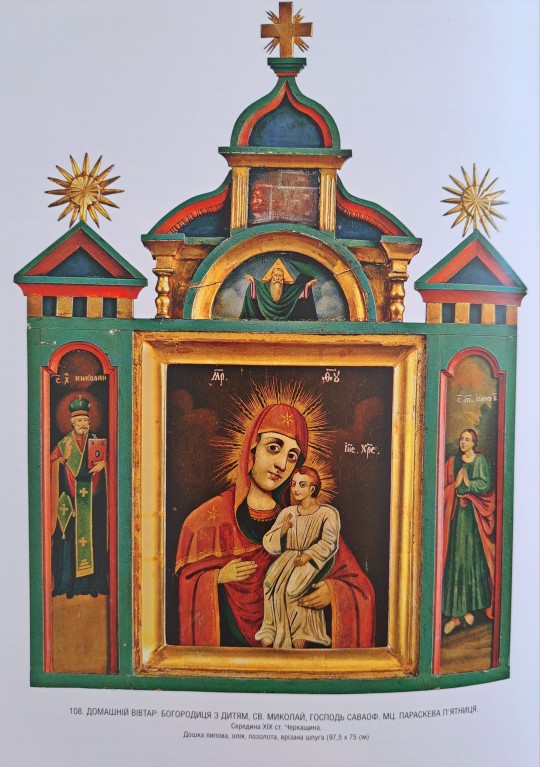





from "folk iconography of middle naddniprianshchyna in 18-20th century"
542 notes
·
View notes
Text
When the human known to us as Christ arrived in the underworld, gods and shades alike were horrified. It was always a big deal when demigods arrived in the underworld, but this one had died so brutally, a young man, not even old enough to grow a beard, tourtued to death at the will of his own divine parentage, the blood dripping from his shade's hands.
The high gods of the underworld brought him up to their tower to figure out what happened. Christ had recoiled from them at first, thinking they were Devils, but had to take Anubis's hand to ascend the tower's steps, as his legs were badly wounded. The gods of the dead looked at him with both sympathy and horror, it was the first time a he had seen a god look at him with either of those emotions.
Hades swore that this was his brother's doing, but even then it crossed a new line. The description of a god impregnating a young girl in Bethlehem fit what Hades knew of Zeus, but to harm his own son in such a way, as part of a ploy to try to gain all of Rome for him alone, had proven his brother's reign growing darker. Still, he took mercy on the young man, promising him at least three days safety in the underworld without his father trying to claim him again. Hades wondered if the poor girl knew when she held her child that he was born to suffer and die, just as the mothers of great heros knew their destiny. Hades hoped Chrsit would have a chance to stay longer, his wife would return in the fall, and he had the same kind eyes as her, she would probably like to know him.
Hel came to comfort Christ once he had a chance to rest. She helped tend his wounds, and pet his head, and for the first time christ was held by a divinity that didn't expect anything from him. And she told him stories of her father to cheer him up after meeting with such a horrible fate. And she told him that no father should ever do such a thing as what his father had done to his child, that if she had known in time she would have saved him. And she let him be comforted as a human, instead of being a lord of all humanity. And for a momment he didn't have to be the son of god who felt alone while bleeding and dying, but the son of the carpenter Joseph who had been reminded of home when he felt the wood of the cross.
He wasn't allowed to stay, his father wanted him back, back to be the bleeding prince of a new and lonely kingdom. And the underworld wept for him, not because the underworld was deprived of Christ, but because Christ was deprived of the underworld.
#196#my thougts#worldbuilding#writing#my writing#my worldbuilding#urban fantasy#myth#mythology#norse mythology#greek gods#greek mythology#norse paganism#norse gods#paganism#hel#hel goddess#hades#jesus#jesus fandom#short story#short fiction#flash fiction#gods#anti christianity#christanity#bible fandom#bible fanfiction#mythology and folklore#folklore
231 notes
·
View notes
Text

Roland Furieux (Orlando Furioso) by Gustave Doré
#gustave doré#art#roland furieux#orlando furioso#knight#hippogryph#hippogriff#knights#chivalric romance#knight errant#chivalry#medieval#middle ages#mythical creatures#legendary creature#europe#european#mythology#folklore#magical#history#ludovico ariosto#mediaeval#christian#christianity#religion#angel#angels
101 notes
·
View notes
Text
Daily reminder that Jesus would have flipped a majority of Republican politicians tables!! Making profit off of God and the word of God is exactly what the merchants did to get their table flipped.
#christianity#christian#christian witch#catholic witch#catholic#catholicism#folk magic#folk magick#folk catholicism#folk catholic#folk practitioner#saints#jesus#yeshua#virgin mary#mary magdalene#folk christianity#folklore#cuban catholicism#loramysti#loramysti on tiktok#leftist#leftism#the gospels#word of god#jesus flipped the tables#bible#bible scripture#disciples
65 notes
·
View notes
Text
The Exorcists’ Masks of Virtue
The vast majority of Exorcists in Hazbin Hotel have a notable design element that other angels don’t: their masks are missing an eye. Specifically, the right eye.


I believe this is a reference to the Bible, Matthew 5:29. Jesus says, “If your right eye causes you to stumble, gouge it out and throw it away. It is better for you to lose one part of your body than for your whole body to be thrown into hell.”
He’s being hyperbolic. Mr Free Healthcare was not pro-mutilation. What he means is that you have to be willing to make sacrifices to prevent sin. The context of the eye metaphor is him condemning adultery and warning that even something as easy, casual and small as a look full of lustful intent can lead to further, worse sin if you don’t notice your sin, hold yourself accountable for it and do the work to not let it influence your decisions. This will probably be hard. It could be very, very painful. Changing your perspective can feel as horrible as plucking out your eye, so many people can’t bring themselves to do it. But although it won’t feel that way in the moment, it’s healthier for our general wellbeing in the long run to abandon traits and behaviours that damage ourselves and/or others.
(You may notice that Jesus’s teaching that you can have sinned, redeem yourself by giving up sin and thus escape damnation is the founding principle of the Hazbin Hotel. You may also notice that it contradicts everything the Exorcists believe.)
The Exorcists seem to follow this idea of painfully excising badness for the sake of the greater good devoutly to the point of placing it above teachings like ‘Thou shalt not kill’, with their job being to remove sin, in the form of sinners, to protect Heaven. Hence the missing right eyes. They’re a declaration of moral righteousness and inability to stumble.
But the truth is that the Exorcists all have their right eyes. Their flawlessness is a facade. Underneath, they are untouched, think themselves morally untouchable and, as shown by their horror and outrage when even one of them is killed, would much rather be physically untouchable too. This perfectly represents their complete unwillingness to acknowledge their own faults, let alone improve. They are never the ones who sacrifice. They force the sinners to sacrifice and don’t compensate it with any salvation. They metaphorically rip out the sinners’ eyes, but still condemn their entire bodies as inherently, permanently sinful. So they’ll just have to do another Extermination to get the other eyes! And another one to cut off their right hands! And so on until there’s nothing left.
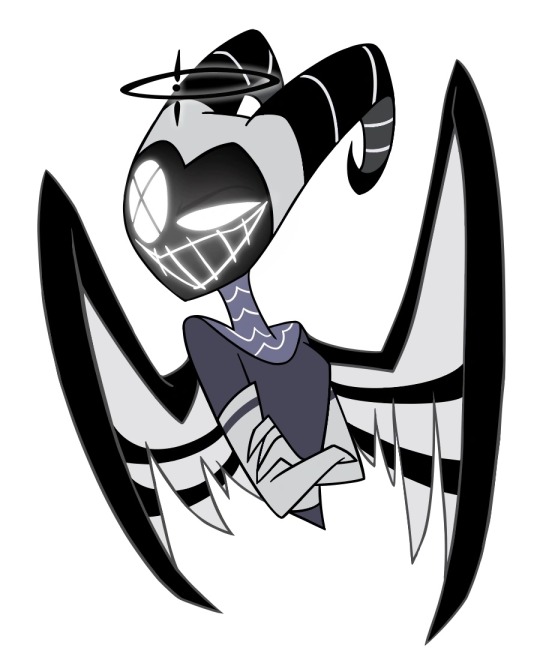

The only exception to the rule is Vaggie, both in appearance and character. Her mask has the left eye crossed out instead. Even before her expulsion, she’s set apart to the audience as an Exorcist who has the capacity to, shall we say, see a different side of things. Her mask having its ‘sinful’ right eye reflects her understanding that the Exorcist worldview is wrong.

When she almost kills a demon child, her hateful vision clears. She discards the part of herself that’s an unquestioning, merciless agent of death, terror and grief… and as punishment for what Lute perceives as treacherous weakness, gets her eye plucked out.

Of course Lute leaves her with only the ‘sinful’ eye. It brands Vaggie forever as the inversion, a perversion, of what the Exorcists are meant to be.

You know, all this talk of eye removal in the Bible reminds me of another line - ‘an eye for an eye’. Adam directly quotes it in “Hell is Forever”. He uses it to frame the Exterminations as Old Testament-style punitive justice; the sinners did harm and so they receive it. But putting aside the debate about how ethical the concept of revenge is, the entire point of taking an eye for an eye is that it’s proportional. The punishment fits the crime. If someone cuts your eye out, you shouldn’t murder their whole family in front of them and then slowly disembowel them to death. That would be the sin of wrath. You should just make them pay without excessive pain or collateral damage. This is the fairest form of revenge.
The Exorcists don’t do that! The Exterminations aren’t proportional to the wrongs of all they hurt, nor was Vaggie’s brutal punishment equivalent to her extremely mild insubordination. Lute literally takes Vaggie’s eye, and more, after Vaggie does nothing to her! That’s the opposite of the phrase! Adam and his soldiers are wrathful and cruel, deriving satisfaction from others’ suffering. But they just can’t stop going on and on about how disgustingly evil the sinners are, in total hypocrisy… despite some of the sinners being far better people than the genocidal Exorcists are… it’s like they’re obsessed with specks of dust in the sinners’ eyes when they have massive logs stuck in their own. Oh hey, that’s in the Bible too!
#both emotionally and symbolically i am rooting for vaggie or charlie to take out one of lute’s eyes#i was like ‘cool vaggie’s missing the opposite eye to her former mask!’#and then i went back and saw that her mask was also different#and then i went down a rabbit hole of biblical mentions of bad things happening to eyes#i know god and jesus (and the holy spirit) probably won’t appear in the show#at least not in person#but i do cherish the mental image of adam and his genocidal army hanging out#when jesus christ bursts in with a whip#and gets all ‘you have made my father’s house into a den of thieves’ on them but an order of magnitude more intense#because HE SAID LOVE ONE ANOTHER#WHERE IS THE LOVE#HE SPECIFICALLY REQUESTED IT#i’m not christian! i’m a hardcore atheist!#religion is just as fictious to me as egyptian mythology#however i am also autistic and have major special interests in mythology and folklore#so here i am fervently writing analysis of the sermon on the mount#hazbin hotel#hazbin vaggie#hazbin hotel vaggie#vaggie#hazbin hotel exorcists#hazbin exorcists#hazbin hotel analysis#hazbin analysis
328 notes
·
View notes
Text

†
#goth#gothic#gothcore#rural#midwest#rural decay#preachers daughter#preacher’s daughter#religious imagery#religion#christianity#appalachia#interiors#home decor#home design#appalachian folklore#ruralcore#rural photography#rural life#rural america#small town america#small town usa
510 notes
·
View notes
Text
Did Christianity Steal From Paganism? Yes... No... It's Complicated. Part 2: Vikings
Tis the season so I figured I'd talk about the topic that's been the subject of debate for a long time, most recently with the 2024 Olympics. I will be discussing the visual aspect of these religions, not the theological aspects.
Short answer: Yes
Long answer: No
Let's get into it: The Viking era is from 800-1050 AD and can be divided into seven parts based off the style of visual art that was popular. The first style is called the Oseberg style (775-800 AD) and would be the basis of all the Viking styles of art after it. It was made of three forms that were derived from Pagan pre-Viking art: ribbon animals, gripping beasts, and ambiguous forms. You can see it on the bow of the ship below; the ship dates to the 9th century and was found in a burial mound in Tønsberg, Norway. Remember these forms because they're going to be important later.
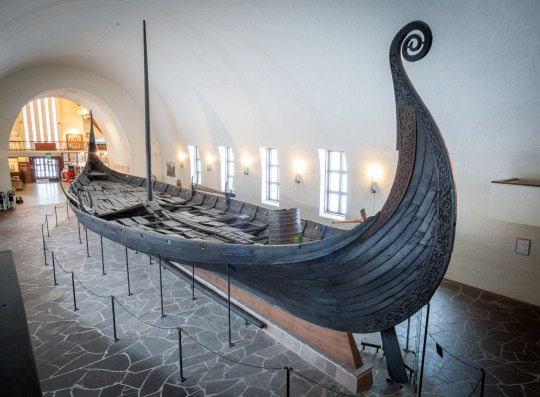
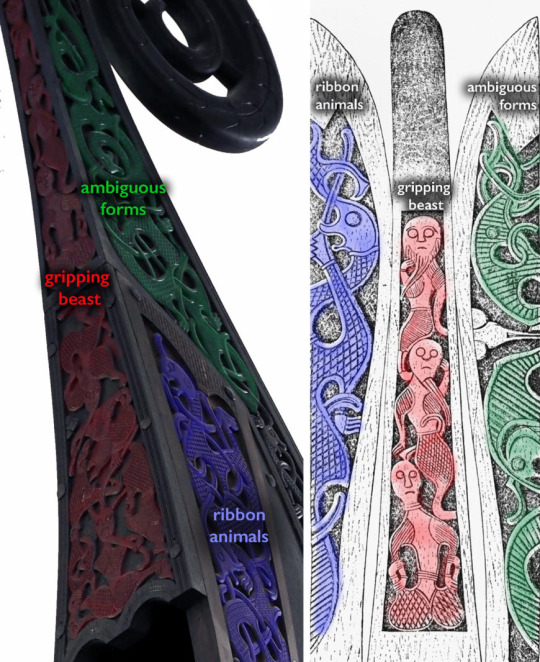
The Vikings started coming into contact with Christian Anglo Saxon (modern day English) missionaries in the 700-800s, but they had little effect. The missionaries were well received by the kings but when their Pagan chieftains threatened to rescind their support, the missionaries were sent away. Another example of that is in 878 AD, the Christian king of the Anglo Saxons, Alfred the Great of Wessex, and the Pagan king of the Vikings, Guthrum the Old, were at war. King Alfred ended up winning and as part of the peace treaty, Guthrum had to get baptized into Christianity. He did so but maintained his Pagan worship and did not implement Christianity.
Besides the kings, common people had also started to slowly assimilate to Christianity. Christians had a rule that they couldn't trade with Pagans so Pagan Vikings began primsigning. Primsigning is an old Norse word meaning "to make the sign of the cross," the way to show you followed Christian beliefs before converting all the way through baptism. Even though they weren't being baptized and were still practicing Paganism, primsigning was enough for Christians to feel comfortable trading with them and brought the Vikings more into the world of Christianity.
An interesting example of this is in Kopparsvik, Sweden, where a large number of Viking individuals were buried in a prone position from 900-1050 AD. This is completely different from traditional Pagan Viking burials: there were no grave goods, no animal sacrifices, no mighty ships. Typically, a prone position is a sign of showing humility towards God and all the figures had notches carved into their teeth (below). Historians theorize that they used the notches to secretly signal to Christian merchants that they were also Christian to get discounts while not being alienated from their Pagan communities.
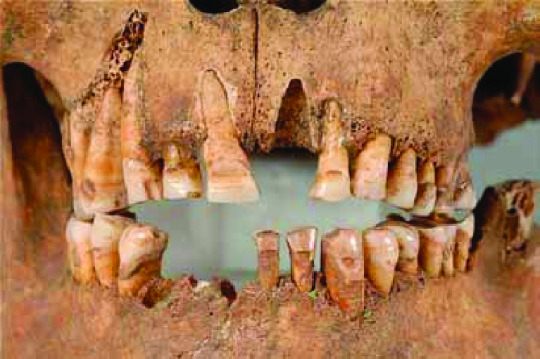

The coin below is from ~921 AD. It's a Viking coin from York, England and wonderfully shows the mixing of Pagan and Christian iconography. Coins like this typically had the name of the Viking king engraved on them but this one has "St. Peter." However, it also depicts the hammer of Thor on both the head (left) and reverse (right). It really demonstrates the visual mixing of religions.
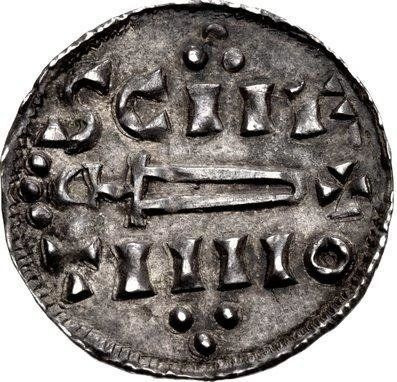
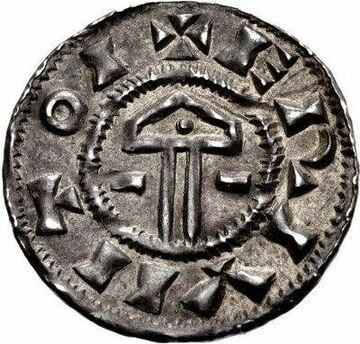
Sometime between 940-1000 AD, the cross below was made. It was found in St Andrew's Church, Andreas, Isle of Man (between England and Ireland), and is another great example of the combination of Pagan and Christian art. On one side (left) it depicts Odin with one of his ravens fighting the wolf Fenrir at Ragnarök. The other side (right) depicts Christ triumphing over Satan. Both of these are stories of good vs evil and depict a god triumphing at the end of days. It would have drawn attention to the theological similarities between Christianity and Norse Paganism, making it easier for people to conflate the differing theologies.
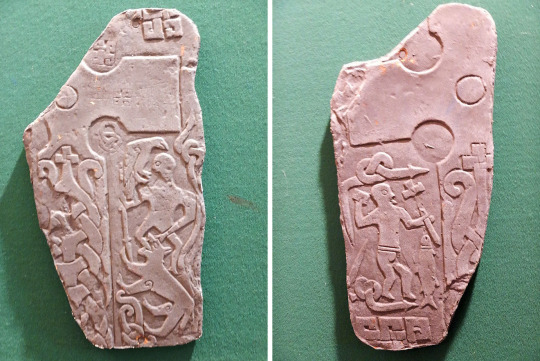
Remember the Oseberg style from before? We're going to revisit it. By the 900s, Viking art was being done in the Mamman style; the ribbon animals and gripping beasts had combined into an icon called the Great Beast. The Great Beast was a symbol of power and strength, frequently put on longships and other Pagan items. In 986 AD, Viking King Bluetooth, a recent convert to Christianity, had the jelling stone below erected in honor of his deceased parents. On one side, he included a Great Beast; this was to show the strength and nobility of his parents and the nation they ruled. On the other side, he put an image of Christ Triumphant. This makes sense for a cenotaph as the promise of a resurrection is a comfort in the face of death. But the combination of a Pagan symbol of strength and an image of Christ is very interesting; it's doing more than pointing out the similarities between the two religions, it's uniting both Pagan and Christian subjects under his rule and proudly displaying the two different sources of the Viking's strength.
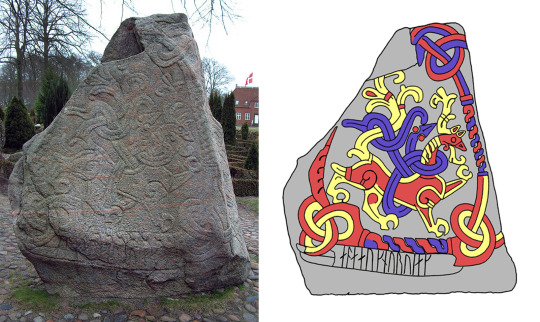
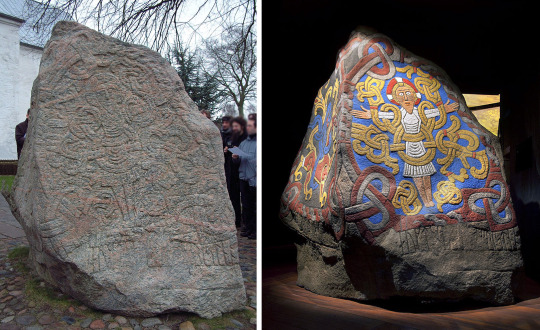
I can't end this without also talking about architecture. The last Viking art style is called the Urnes style and it's primarily because of the church below. It was built in 1132 AD in Urnes, Norway and is a stave church, meaning the whole thing was built without any nails!! The entire thing is self-supporting wood made using the post and lintel system. It's a Chrisitan church but has Pagan iconography on the sides: the last version of the Great Beast (right) and Pagan runes. It's fascinating how a Christian place of worship is decorated and protected by Pagan icons, once again showing the combination of visual cultures and methods of thought.
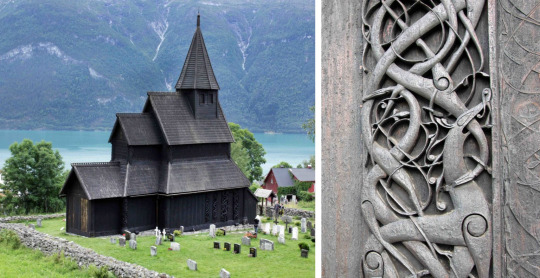
So, the answer everyone is looking for is NO.
The Christians didn't steal anything from the Pagans, they made an association. They produced art in the style that was popular and followed the artistic trends of the time. Christian and Pagan imagery was produced in the same medium and combined until Paganism was phased out over hundreds of years. They saw similar gods and iconography and combined them to make a message that was understandable to all audiences.
Happy Yule! Happy Winter Solstice!
Further reading:
Smarthistory – Art of the Viking Age
BBC - History - Ancient History in depth: Viking Religion
The Vikings and Christianity | History of Christian Vikings – Sons of Vikings
Treaty of Wedmore - Wikipedia
Manx runestones - Wikipedia
Prone Burials and Modified Teeth at the Viking Age Cemetery of Kopparsvik - Historische Beratung Dr. Matthias Toplak
Ancient Viking Art - Medievalists.net
Gamla Uppsala - Wikipedia
#i tried to include both academic and general further readings#this is very simplified bc i'm trying to give a general overview#yule#artist talk#ancient art#pagan witch#paganism#pagan#paganblr#christianity#norse paganism#celtic paganism#norse mythology#celtic mythology#norse art#celtic art#scandinavian folklore#scandinavian mythology#thor#odin#jesus christ#norse heathen#heathenism#winter solstice
62 notes
·
View notes